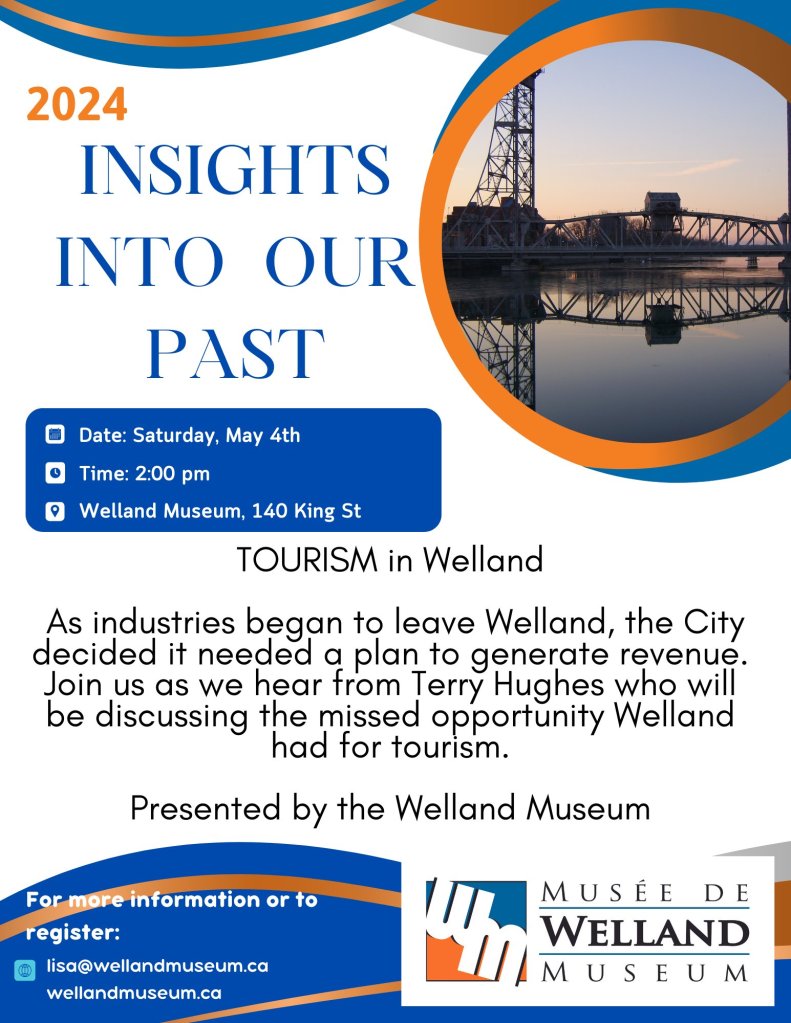Please support/attend this interesting community event







Captions: Clockwise from top left, the structural magnificence of the second Aqueduct as it was being covered during the construction of the fourth canal that is now the parking lot behind the civic centre and promoted as a historical structure by the WRCC (Supplied photo); Willow Walk signage, Merritt Island (file photo, Joe Barkovich); One of several plaques showing the significant role played by the Feeder Canal as part of our heritage (file photo, Joe Barkovich); Tranquil beauty of Willow Walk trail (file photo, Joe Barkovich); Plan for the development of Feeder Park sponsored by the WRCC (supplied graphic).
Part 4: A NEW GOVERNANCE MODEL AND DIRECTION FOR TOURISM
By Terry Hughes
In the previous article, it was mentioned that Mayor Dick Reuter’s attention to develop the new plan for the civic centre had halted any further progress on the development of a canal board with the acquisition of the canal lands. The election of Cindy Forster as mayor and then the development of an incorporated board did not indicate what type of terms of reference were adopted. Though not being privy to that information, it became known that a four-point list of references was developed primarily using the Welland Canal Parkway Development Board as a reference. The four principles of these terms were:
1. The lands and waterway be for the use and enjoyment of the people of the city of Welland.
2. Historic sites and structures be maintained and enhanced as part of our heritage.
3. Development should be encouraged between the private and public sector using long-term leases as one source of revenue.
4. Development must embrace environmental standards and laws at all levels of government.
One of the issues that became part of the next election for mayor was the lack of action to attract tourism using the abandoned canal as an attraction. A meeting attracting 80 people was held at the Best Western, chaired by Arlene Whyte from the Ministry of Tourism, where a variety of ideas were shared.
In a story appearing in the local daily newspaper under the headline Tourism Has Been Done On The Cheap, it was noted that Port Colborne has done a better job in marketing their Canal Days and Tall Ships event while we use a local approach called TOWN (Tourism of Welland Niagara) as a tool for promoting our city. Everybody is directed to Thorold or Port Colborne to see the locks while we, too, have local canal attractions like a 150- year- old aqueduct, the oldest structure of its kind in Canada next to its modern counterpart, the Syphon. The Main Street Bridge was the largest and most expensive lift span on the canal. Couple those items with the murals project. In a follow-up article in the newspaper, I was quoted as saying “In Welland, the political will was not there and the local boo birds added shouts of negativity.”
Using tourism as part of his platform, Mayor Damian Goulbourne initiated a number of changes in the operation of the WRCC (Welland Recreational Canal Corporation). He left the operation to the board using one of its appointments as the chair. City council would continue being represented as before. An executive director was selected to administer the board and maintenance issues and while not using city employees. Goulbourne opened the board to investigate new and innovative ideas to attract tourism. The “Go Quiet” approach to operating power watercraft was supported thus negating a constant headache and protecting the city from possible injuries on the water, resulting in lawsuits. Charting the course for development of the canal lands was a meeting involving some two hundred people at Notre Dame College School resulting in a master plan in 2014.
After looking at a number of water courses in Europe, the idea of developing a flatwater course evolved. We, here in Canada, did not have an adequate facility and therefore, the waterway would be a good fit. The Welland International Flatwater Course was born!
Heritage and sports activities were encouraged. Although initially planned as part of the entrance to the flatwater course, Feeder Park would be enhanced. A change to the south end near the earthen plug reduced this project to its present site, the Canal Terrace was erected noting the role played by King Street as part of our heritage. Twice the WRCC endorsed the development of the Cross Street pool as a heritage site. Our Burwell Triathlon continued to flourish and received comments by its participants as one of the best in Ontario. And how about those wonderful nature trails and YMCA programs available at the Blue Building on Merritt Island! And one of the best things to draw people from outside of the city was the Illuminaqua. It initially was listed as one of the top hundred tourism activities in Ontario.
Finally the gloves were off and something was at long last happening. Today, we have one of the best flatwater facilities here in Canada.
Next: Part 5 Ghosts of the WRCC – Controversy And Change
(Terry Hughes is a Wellander who is passionate about heritage, history and model
railroading. His opinion column, Heritage Lives, appears on the blog once or twice monthly.)

Part 3: Incorporation And A Comparison Of Canal Land Development By Two Administrations
By Terry Hughes
During the negotiations between the city and the federal government, a number of legitimate concerns were raised by Mayor Dick Reuter in a letter to our M.P. Gib Parent in 1994.
He states that “physical liabilities such as the collapse of the aqueduct, canal bank and their retaining structures” and other issues must be considered. A public relations campaign was initiated by the city planning department on the latter featuring local radio personality Frank Sernak on a professionally developed video.
Interestingly, Public Works Canada had commissioned a study on canal bank erosion by Acres in 1993. They noted that “the north reach (from north of the aqueduct to the train trestle) has experienced most of this phenomena because of the high banks in this portion of the canal.” Estimates made on this issue were costed out at spending two hundred and fifty thousand dollars for twenty-five years. I don’t believe that any remediation on this problem has occurred.
In 1996, the Welland Canal Parkway Development Board resigned. Pressure from government officials for us to become involved in the negotiation process between the federal government and the city led to this decision, however, discussions between the chair, Mr. Parent, Mayor Reuter and Coun. Joe Spadafora continued on a governance model.
1997 was a memorable year for a number of reasons. I retired from the teaching profession, became involved in the federal election but more importantly the city and federal government settled on transferring the canal lands to the city. I recall Mayor Reuter suggested to Coun. Spadafora that a symbolic dollar bill be placed on the wall of the mayor’s office celebrating the deal.
The mayor’s attention quickly changed to the issue of building a new city hall. Controversy over building a swimming pool under the facility would become a local election issue. That would end further involvement between local officials on a new board. But the need to have the new mayor aware of a framework for a governance model and the need to have it incorporated became important. The significance of a new board and its incorporation was presented to Mayor Cindy Forster’s first council meeting.
The Cindy Forster Canal Board
The operation of this board was very similar to the parks and recreation department. Until the incorporation of the board, money secured from the deal with the federal government was used for non canal land purposes.
Soon it became evident that the board was not in the tourism business. The possible reason was that the mayor who chaired the committee as well as being mayor of the city left little time for investigating tourist opportunities.
That issue would come under jurisdiction of the committee called TOWN (Tourism of Welland Niagara). Instead, motorized boating became a major issue in terms of numbers and the operation of watercraft. There wasn’t any way to enforce coast guard rules because they lacked qualified officers. If they hired off-duty regional police, it could become very expensive as the committee running the triathlon found out. In the meantime, the marine unit of the regional police was overwhelmed patrolling the multitude of waterways in the region. When they did arrive here the number of boaters found to be drunk was greater than the provincial average.
One of the greatest disappointments during the operation of this board was the filling in and placement of structures in the Cross Street swimming pool during the construction of the city centre. At no time was anyone in the heritage community advised or consulted as to what plans the board had for this piece of history. All that was achieved was the further disguising of this valued structure.
The birth of the WRCC (Welland Recreational Canal Corporation) at its time of incorporation was a positive step because now, the funding for the operation of the canal lands from any future takeover due to municipal reorganization was secure. The fund was now to be used for canal land purposes only. Better paved bicycle/walking paths were built on the west bank of the canal. But the frustration over the lack of tourism development would become the major issue that would fuel the next election.
Next in the Ghosts series: A New Governance Model And Direction For Tourism.
(Terry Hughes is a Wellander who is passionate about heritage, history and model railroading. His opinion column, Heritage Lives, appears on the blog once or twice monthly.)